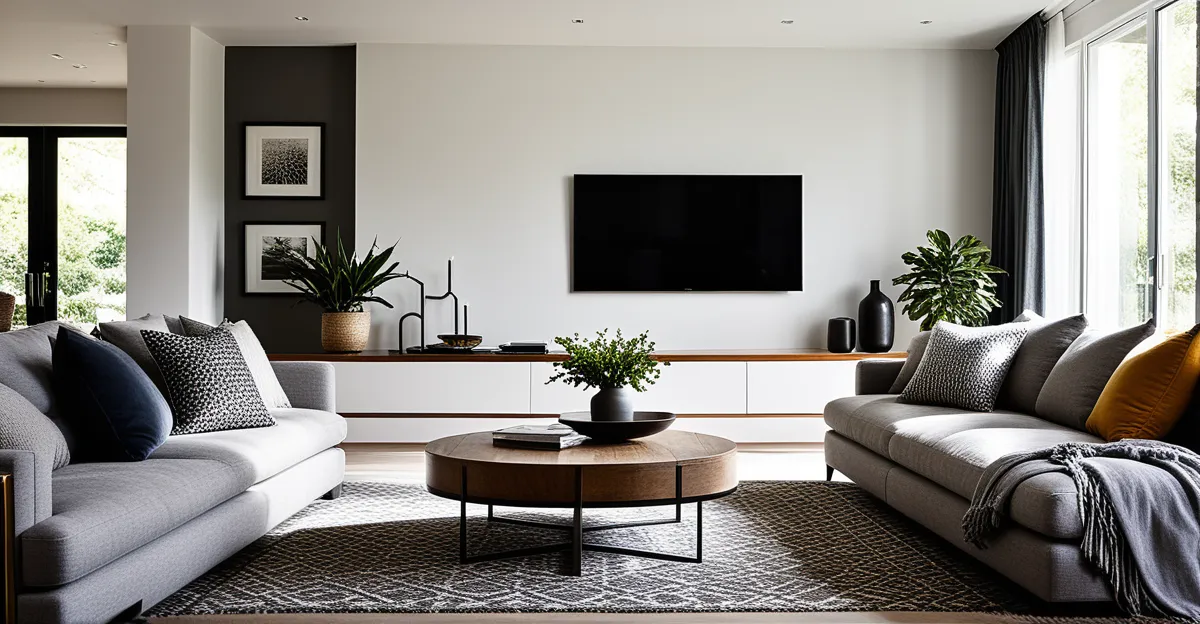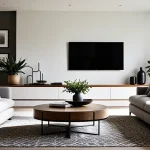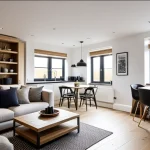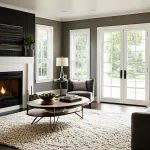Essential Elements for Maximum Living Room Comfort
Creating a truly comfortable living room hinges on several comfort essentials that blend practical needs with aesthetic appeal. First, the key factors defining living room comfort include seating quality, lighting, temperature control, and acoustic ambiance. Each element must contribute to a relaxing yet functional environment suited to your lifestyle.
To identify your comfort priorities, consider how you use your living room daily. For families, durable yet soft furnishings may be paramount, while those who enjoy quiet reading spaces may prioritize plush seating and adjustable lighting. This personalized assessment ensures that your home redesign targets what truly enhances your comfort.
In the same genre : How Can You Transform Your Home into a Stress-Free Sanctuary?
Balancing aesthetics and function is essential. Functional elements like ergonomic seating or strategically placed lighting should not compromise style. Instead, the goal is an environment where beautiful design meets comfortable usability, creating a space where you feel at ease and inspired. Whether it’s the arrangement of furniture for easy movement or selecting materials that welcome touch, these foundational decisions shape the overall comfort of your living room.
Strategic Furniture Arrangement for Comfort
Thoughtful living room furniture arrangement is crucial to achieving both comfort and functionality. An ergonomic layout places seating and tables within easy reach, avoiding awkward angles that can cause strain during use. For example, positioning sofas and chairs to face each other creates inviting conversation zones while maintaining an open flow for movement.
Also to discover : How Can You Transform a Small UK Space into a Cozy Living Area?
Good space planning ensures furniture doesn’t overcrowd the room, allowing clear pathways for easy accessibility. This prevents a cramped feeling and supports smooth traffic flow, which enhances overall living room comfort. When planning, consider how family members and guests naturally move through the space.
Selecting adaptable furniture can significantly boost versatility and comfort. Modular pieces and lightweight chairs make it simple to reconfigure the layout according to changing needs—whether it’s for a casual movie night or hosting guests. Such flexibility aligns perfectly with a thoughtful home redesign, prioritizing comfort essentials tailored to lifestyle.
Choosing Materials and Textiles for a Cozier Ambiance
Selecting the right living room textiles is fundamental to creating a warm, inviting atmosphere that enhances living room comfort. Plush fabrics such as velvet, chenille, and soft cotton blends are top choices for sofa fabrics because they offer both softness and durability. Velvet, for instance, combines elegance with a tactile richness that invites relaxation, making it an excellent comfort essential in any home redesign.
Layering is another effective strategy to boost cozy appeal. Incorporating throws, cushions, and area rugs crafted from natural fibers like wool or cotton adds not only visual warmth but also a tactile dimension. Throws made from chunky knit or faux fur materials provide a comforting embrace, perfect for unwinding after a long day. Using these layers creates a multi-sensory experience that enhances the feeling of comfort while introducing textural variety.
Durability and maintenance are critical considerations, especially in family-friendly living rooms. Opt for textiles that resist stains and wear without sacrificing softness. Performance fabrics designed for high traffic areas combine ease of cleaning with lasting plushness. This balance ensures that comfort does not diminish over time, maintaining the cozy ambiance essential for everyday use.
In summary, carefully chosen cozy materials and thoughtfully layered living room textiles significantly elevate both aesthetics and comfort. They play a pivotal role in any successful home redesign aimed at maximizing relaxation and tactile enjoyment in the living space.
Lighting Techniques that Enhance Relaxation
Creating optimal living room lighting is a crucial comfort essential that influences both mood and usability. Layered lighting strategies combine ambient, task, and accent lighting to foster a flexible and inviting environment. Ambient lighting provides overall illumination, often via ceiling fixtures or recessed lights, setting a soft and welcoming tone.
To answer what makes cozy lighting effective, it focuses on warmth and adjustability. Warm light temperatures (around 2700K to 3000K) mimic natural light’s gentle hues, which promote relaxation and comfort. Incorporating dimmers or smart bulbs allows you to tailor brightness according to different activities and times of day, enhancing the room’s adaptability in a thoughtful home redesign.
Natural light integration also plays a significant role in maximizing living room comfort. Large windows, sheer curtains, or strategically placed mirrors amplify daylight, improving atmosphere and mental well-being. When natural light fades, layered lighting ensures that the space remains comforting rather than harsh or overly bright.
Proper fixture placement is key. Table lamps near seating areas support reading or conversation, while wall sconces add subtle illumination without glare. Floor lamps can fill darker corners, ensuring balanced light throughout. Using a variety of light sources rather than relying on a single overhead fixture reduces eye strain and creates a cozy ambiance.
In summary, combining ambient lighting tips, smart bulb use, and natural light integration are essential tactics in designing living room lighting that enhances relaxation and comfort. These approaches help create a warm, versatile space tailored to everyday living and special moments alike.
Color Schemes That Promote Comfort and Relaxation
Choosing the right living room color palette is a pivotal comfort essential that shapes the room’s emotional ambiance. Colors have a profound psychological impact, influencing mood and feelings of relaxation. Soft, muted tones tend to create a calming atmosphere, while bright or harsh colors can disrupt the sense of comfort.
What are the best comforting colors for a living room? Shades like warm beiges, gentle grays, and pastel blues consistently evoke tranquility and ease. These relaxing hues reduce visual stress and foster a welcoming environment ideal for unwinding. Incorporating subtle earth tones, such as soft greens or clay-inspired colors, can also connect the indoor space to nature, further enhancing comfort and relaxation.
Balancing a serene base with accent colors adds depth and interest without overwhelming the senses. For instance, a neutral backdrop complemented by warm terracotta cushions or mustard-yellow throws introduces warmth and personality while maintaining overall restfulness. This approach enables a nuanced home redesign that prioritizes both living room comfort and stylistic appeal.
In practice, lighting affects how color is perceived, making it essential to test paint or fabric samples under different illumination conditions before finalizing your living room color palette. This step ensures the chosen shades consistently contribute to a soothing atmosphere throughout varying daylight and artificial light scenarios.
To summarize, selecting comforting colors involves choosing tranquil base tones paired with warm accents to cultivate a peaceful yet inviting living space. Thoughtful attention to color psychology and interplay supports any home redesign aimed at maximizing living room comfort.
Decorative Details to Enrich Comfort and Style
Adding cozy decor tips is a vital step to elevate living room comfort, blending softness with personality. Thoughtful use of accessories like poufs, ottomans, curtains, and blankets introduces layers of tactile appeal that invite relaxation. For instance, a plush pouf not only serves as extra seating but also offers a footrest, enhancing ergonomic comfort. Soft curtains regulate natural light and add warmth through texture, while strategically placed blankets encourage a sense of ease and approachability.
Incorporating art and greenery offers more than visual interest; these elements provide a personal, relaxing touch to the space. Art pieces reflecting your style connect you emotionally with your living room, making it feel uniquely yours. Similarly, adding houseplants improves air quality and creates a calming, natural vibe that supports overall comfort—key comfort essentials in a thoughtful home redesign.
Maintaining a clutter-free environment ensures the room remains inviting without sacrificing warmth or character. Combining minimalism with carefully chosen decor allows each piece to shine while preserving a sense of spaciousness. This balance supports constant usability and psychological ease, both crucial for sustained living room comfort. By focusing on these decorative details, you seamlessly enhance comfort and style, making your living room a true haven.






